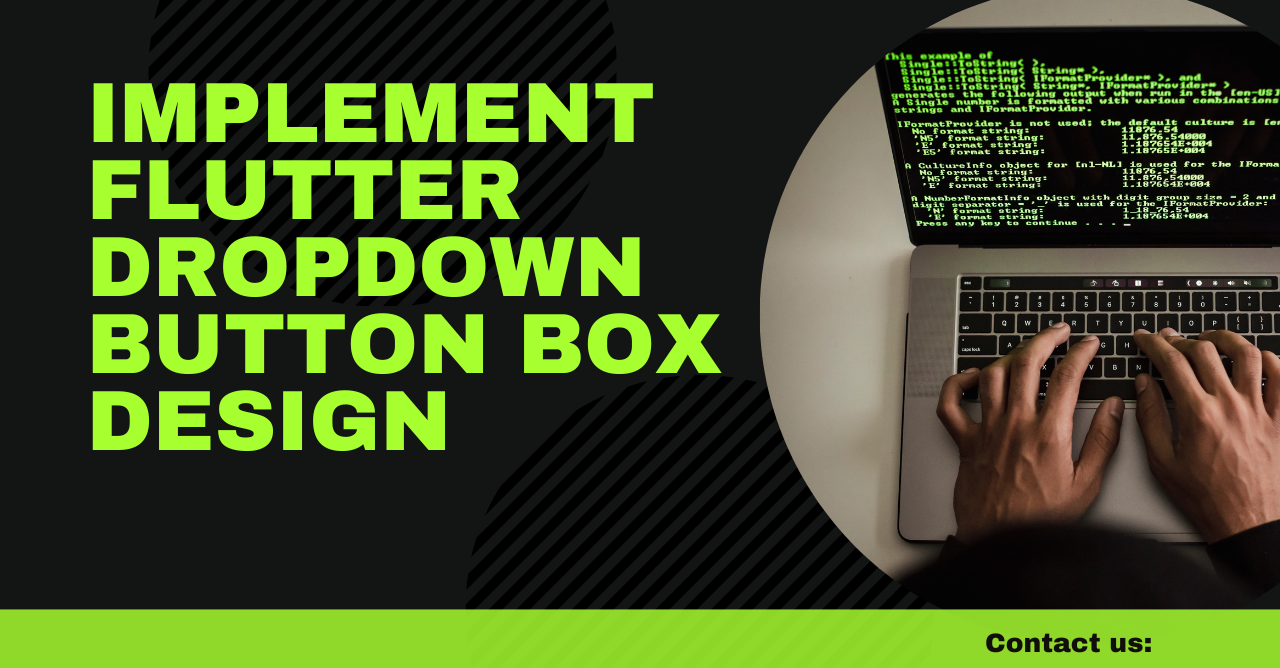How to Implement a Flutter Dropdown Button Box Around the Button
Introduction
In mobile application development, dropdown menus are commonly used to provide users with a selection of options in a compact and user-friendly manner. Flutter, a popular cross-platform framework, offers a versatile widget called the DropdownButton that allows developers to easily implement dropdown menus in their applications. In this tutorial, we will explore how to implement a Flutter dropdown button box around the button, providing a clean and intuitive user interface.
Understanding Flutter Dropdown Button
Before diving into the implementation details, let’s take a moment to understand the Flutter DropdownButton widget. The DropdownButton is a material design widget that displays a button and a menu when tapped. When the menu is shown, it presents a list of items from which the user can choose a selection.
Implementing a Dropdown Button Box in Flutter
Setting up the Flutter Project
To get started, ensure that you have Flutter and the necessary dependencies installed on your development machine. Set up a new Flutter project by running the following command in your terminal:
flutter create dropdown_button_box_example
Navigate to the project directory:
cd dropdown_button_box_example
Open the project in your preferred IDE or code editor to begin implementing the dropdown button box.
Creating a Dropdown Button
To create a dropdown button, we need to define a list of items that will be displayed in the menu. Let’s start by creating a list of fruits as our example items:
List<String> fruits = ['Apple', 'Banana', 'Orange', 'Mango'];
Next, we can use the DropdownButton widget to build the button itself. Here’s an example:
String selectedFruit;
DropdownButton<String>(
value: selectedFruit,
items: fruits.map((String fruit) {
return DropdownMenuItem<String>(
value: fruit,
child: Text(fruit),
);
}).toList(),
onChanged: (String newValue) {
setState(() {
selectedFruit = newValue;
});
},
);
In this code snippet, we define a variable selectedFruit to keep track of the currently selected fruit. The DropdownButton widget takes in a value parameter that represents the selected item, an items parameter which is a list of DropdownMenuItem widgets, and an onChanged callback function that gets called when the user selects an item from the dropdown menu.
Customizing the Dropdown Button Box
Now that we have a basic dropdown button, let’s explore how we can customize its appearance to create a dropdown button box around the button.
Changing the Button’s Appearance
To change the appearance of the button, we can leverage the style parameter of the DropdownButton widget. For example, we can modify the button’s background color, text color, and font size:
DropdownButton<String>(
value: selectedFruit,
items: fruits.map((String fruit) {
return DropdownMenuItem<String>(
value: fruit,
child: Text(fruit),
);
}).toList(),
onChanged: (String newValue) {
setState(() {
selectedFruit = newValue;
});
},
style: TextStyle(
color: Colors.white,
fontSize: 16.0,
fontWeight: FontWeight.bold,
),
// Additional properties...
);
Modifying the Box’s Styling
To modify the box’s styling, we can utilize the dropdownColor and elevation properties. The dropdownColor allows us to change the background color of the dropdown menu, while the elevation property controls the box’s shadow:
DropdownButton<String>(
value: selectedFruit,
items: fruits.map((String fruit) {
return DropdownMenuItem<String>(
value: fruit,
child: Text(fruit),
);
}).toList(),
onChanged: (String newValue) {
setState(() {
selectedFruit = newValue;
});
},
style: TextStyle(
color: Colors.white,
fontSize: 16.0,
fontWeight: FontWeight.bold,
),
dropdownColor: Colors.blue,
elevation: 4,
// Additional properties...
);
Feel free to experiment with other properties of the DropdownButton widget to achieve the desired look and feel for your dropdown button box.
Advanced Techniques and Best Practices
Handling Dropdown Button Events
In addition to customizing the appearance, it’s essential to handle events triggered by the dropdown button. For example, you might want to perform certain actions when the user selects a specific item. To achieve this, we can modify the onChanged callback function:
onChanged: (String newValue) {
setState(() {
selectedFruit = newValue;
});
// Perform additional actions based on the selected item.
// For example, update the UI or make API calls.
},
By extending the functionality of the onChanged callback, you can enhance the user experience and provide meaningful interactions within your application.
Improving User Experience
To improve the user experience, consider implementing features such as search functionality, filtering options, or grouping items within the dropdown menu. These enhancements can make the dropdown button box more powerful and convenient for your users.
Conclusion
In this tutorial, we explored how to implement a Flutter dropdown button box around the button. We learned about the DropdownButton widget and its properties, such as value, items, and onChanged. We also discussed customizing the appearance of the dropdown button box by modifying the button’s style and the box’s styling. Additionally, we touched upon advanced techniques like handling events and improving user experience.
By following the steps outlined in this tutorial, you can create intuitive and visually appealing dropdown button boxes in your Flutter applications. Remember to experiment with different customization options and consider the needs of your target users to provide a seamless and delightful experience.
FAQs
Q: Can I have multiple dropdown button boxes in a single Flutter screen?
A: Yes, you can have multiple dropdown button boxes in a single Flutter screen. Each dropdown button box should have its own set of items and value variable to track the selected item.
Q: How can I dynamically update the items in a dropdown button box?
A: To dynamically update the items in a dropdown button box, you can update the list of items in your stateful widget’s build method. By calling setState with the new list of items, Flutter will rebuild the widget tree, reflecting the updated items in the dropdown menu.
References:
- Flutter documentation: https://flutter.dev/docs
- DropdownButton class documentation: https://api.flutter.dev/flutter/material/DropdownButton-class.html
- Flutter DropdownButton tutorial: https://flutter.dev/docs/cookbook/forms/dropdown-button


